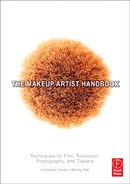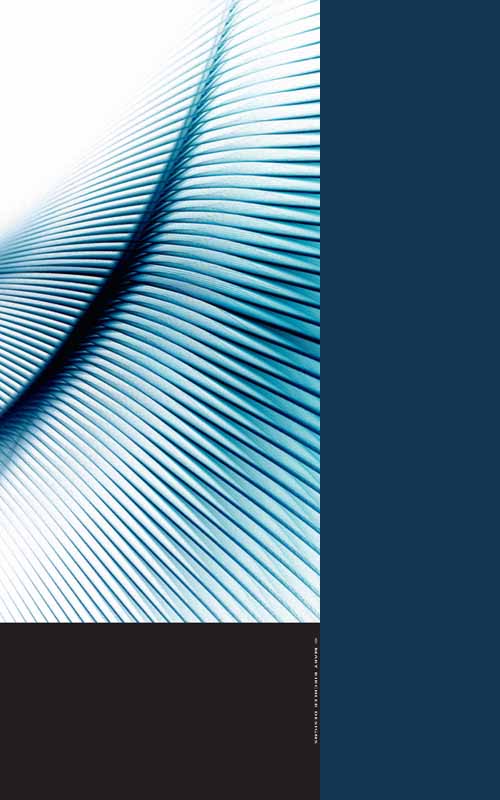HOW TO BE A PRO | 12
DAY CHECKING: FILM AND TELEVISION INDUSTRY
Sometimes Makeup Artists work on a day-to-day basis; this is known as day checking. Working as a daily hire takes a certain amount of responsibility and know-how. If you are someone who is talented plus have the ability to think on your feet and are a good observer, you’ll go far. Department heads look for someone they can trust onset, to do the job asked and not use the time at work to advance your own career. There is a real need for good daily hires, or Day Checkers. Once you have worked with someone a number of times, you’ll get an idea of how the department heads run their Makeup Department. No matter how chummy and laid back it might seem, try to remember that you are at work and this is a real job. Don’t allow yourself to be careless with what you say and too chatty with the Makeup Artists in the main trailer. One of the biggest mistakes a Makeup Artist can do in any situation is not follow directions! Please leave your ego out of the equation when given directions on how and what products to use for the job you are on. There have already been many decisions made by the department heads in charge about the look of the shoot. Do as you’re told! On top of being called to work without much information, walking into a job that might already be in progress with a group who have already established a relationship with each other can be tough. There are ways to make sure you are on the right track. The following will help you to understand the dos and don’ts of a Day Checker for daily hire, and how to watch the set.
DAY CHECKING DOS: DAILY HIRE FOR FILM
When called in to work, ask the Production Department to fax or email you a call sheet for the day you are working (Figures 12.1 and 12.2). If you have been contacted by a department head or another Makeup Artist, be sure to get the information you need, such as a production number. Sometimes the Makeup team already working has a full plate. You can help by contacting Production yourself to let them know who you are. Inform Production that you are onboard and in what department. Production can then add you to the list of Crew members to be contacted for call times. Wait about an hour after Production wraps the night before you are to work. If you have not heard from someone by then, call to remind Production that you need a call time. Note that it is the AD’s department with the help of the production department to give call times, but in some cases a member of the makeup department will make the calls.
Many times department heads will contact you to ask if you have your call times. It is a plus to say yes because that makes one less thing for the Makeup Artist to worry about. They know you will be reliable to find your way to the Makeup trailer and on time. Sometimes you can sense a crazy, hectic situation, so be proactive and get the information you need yourself to get to work the next day. Expect a call from an AD. When you do get your call sheet, read it carefully. Take mental notes on what is being shot, how many background players there are, what is the time period, whether it day or night, interior or exterior.
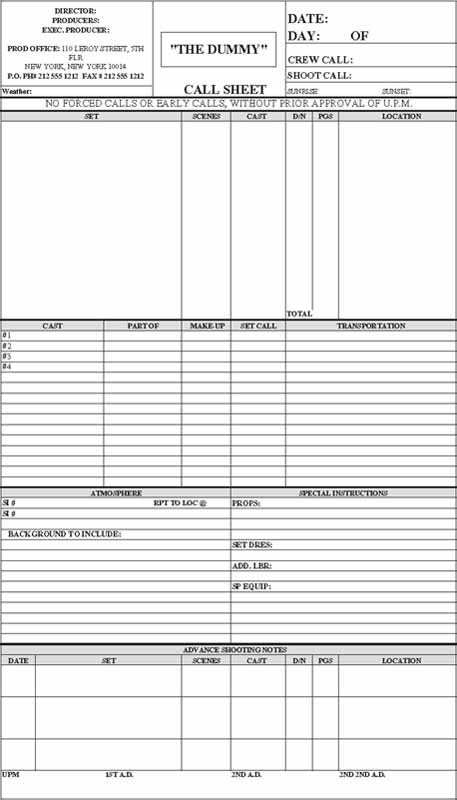

Why is it important to know these things? If the weather is bad, bring the right things to wear. Are you outside all day? Be prepared to work under any weather situations and for long lengths of time. Layered clothing is a must when working outdoors; bring items such as scarves, rain boots, coats, and sweaters. Maybe your set bag needs to be plastic or covered to protect it from the rain. Should you bring an umbrella? What if you are outside all day and it is hot? Sunscreen will be a must to apply on yourself and on the actors you are working on. Hats also protect you from the sun. Sunglasses help with the glare. Working indoors can mean cramped spaces, humid air, and possible excess sweat. Indoors, you might want to stay compact and bring a small portable fan for a little airflow. How many background players are coming in? Reading this information will tell you how busy it is going to get. The call sheet will also tell you what time period the movie is in for that day. Adjust your makeup kit to what you’ll need. Don’t bring in natural makeup colors if you are creating 1980s characters. Use common sense. These are just a few examples of why it is important to read the call sheet and to figure out how to prepare for the day.
ON THE JOB
How to Read a Call Sheet
Reading the call sheet gives you valuable information. If you are day checking, reading what scenes are being shot, how many background artists will be working, and what parts they will be playing is important information for preparing what you will need to bring to work. The call sheet will also tell you where to go and what time to be there, who to call in cases of an emergency, and who else will be working with you. The following numbers correspond to the numbers on the call sheet and explain what they mean. A film call sheet is two sided; a commercial call sheet typically is one sided. This is a film call sheet.
• Name of the production company, their location, and phone numbers. In case there is an emergency, you can contact the Production office to find out what your call times are or where you are supposed to be.
• Names of all the Producers, Assistant Directors (ADs), Writers, and the Director. It is good to know who the ADs will be. Besides the makeup department, you will be dealing with AD department. They control the set, the schedule, and the environment on the set.
• The first time listed is the crew call. This is also called the general crew call, and is the time that most of the crew reports for work. Not the makeup department, we have a separate call time, usually much earlier. Do not confuse the crew call with the Makeup call, they are usually not the same. The second time listed is the shoot call. This is the time that production has scheduled to starting filming. Makeup call times are on the back of the sheet for film and on the front of the sheet for commercials.
• Date of the day of work. Amount of days the production has already been shooting. This is good to know because you can judge how fresh or tired the Makeup Department might be when you first start working. The more days they have been filming the more tired!
Crew Call: the time the Crew is called into work.
Weather forecast for the day of shooting. Helps you decide what to wear to be comfortable and protected. This would also include any protection you might need for your makeup kits, or for your actors.
Closed Set: A closed set means no visitors. Please remember this rule. You are there to work. It is not a time to show your friends the set. There will be names listed for you to contact to get permission to bring someone on-set.
SC(scene): Scene numbers in the script being shot that day.
Set Description: What is being shot and what the shot looks like. If the shot is indoors or outdoors.
D/N: Day or Night. Indicates if the scene being shot is a day scene or night scene.
Pages: The number of script pages for the scene being shot.
Cast: The cast members appearing in the scene being shot.
Locations: Where the scene(s) is/are being shot.
Holding and Catering: Where the extras are being held, and where the food is located.
Total Pages: Total number of pages being shot that day.
Cast: Actors working that day.
Character(s): Name(s) of the character(s) the actor(s) will be playing. Each character is assigned a number, this number is used to show the character on the call sheet and shooting schedule.
Stat: Work status of the actor. Shows if they work that day or are on hold, or traveling or off.
Reh: Time of rehearsals for the actor(s).
H/MU: The time the actor(s) will go to Hair and Makeup.
Set Call: Time the actors are expected on set.
Remarks: What time the actors will be picked up from their hotel, or home, or if they self drive.
Atmosphere Stand-ins: How many standins and background actors are working that day. Also, what characters they play.
Report: What time stand-ins and background actors report to Hair, Makeup, and Wardrobe.
Set Call: The time stand-ins and background actors report to set.
Remarks: Directions on where to report and at what time for stand-ins and background actors.
Department Requirements: Notes on what each department needs to have for scenes being worked that day. Example: Makeup Dept. blood for scene xx.
Advance Schedule: What scenes will shoot and where for the next few days.
Producers, Production Supervisor, and first AD sign off on (approve) the call sheet. Set phone number and contact in case of an emergency.
Flip side of the call sheet: All Departments and the names of the Crew members listed and their call times.
DAY CHECKING: DAILY HIRE FOR COMMERCIALS
Being called in as a daily hire for commercials is similar to film. There are a few changes that you would need to be aware of. Call sheets are not as extensive, and tend to have all information on the front, sometimes with a storyboard attached so you know how the commercial is being shot. You do not have to worry about bringing in copies of your IDs. Copies might be made for you by production, but even that might not happen. A day rate is also decided on between yourself and the Producers. What you charge is up to you, but never go below the asking rate. Remember that the less you charge, the more people perceive you as someone who is not in demand. When assisting another Makeup Artist, he or she will tell you what they have in the budget for you. Working with another pro is a good experience. Working by yourself means more responsibility, so remember to keep your rates where they should be. You’ll be asking for a flat day rate, with overtime after 10 hours and a kit fee. If you are with a makeup agency, your representative will work out everything for you. After a rate is agreed upon, the agency or Producers might ask for a resume, reel, or CD of your work. This happens mostly if you have never worked with the agency or Producers before, and they want to get an idea of what your makeup looks like in print, and who you have worked for in the past.
Makeup Kits for Day Checking
Day checking, or daily hire, means you are called in one day at a time. Even though you might get a heads-up on more days, don’t count on it. Anything can happen. Although there are people who consider day checking to be the least important part of the Crew, that way of thinking is a big mistake. Department heads recognize the importance of their daily-hire Crew. In general a department head that values their crew, runs a more efficient crew and gets better results in the final outcome of the makeup look desired for the film. As a matter of fact, on a large feature film or project that Makeup Artists want to be involved with, they often work as Day Checkers. Skill is so important on this level, for often you are left alone to make your own judgment calls.
The right makeup kit for the right job is also important. If a department head has phoned ahead to recommend bringing very little or just what is needed, take heed to that request. The department head knows what is going on with their shoot. There is always time to bring in a larger makeup kit if you are hired for more days, or if you are assigned a specialized makeup procedure such as laying down sideburns for a period piece You most likely have had conversations with the department head on any special makeup to bring with you. Every now and then, a production comes to town and the Makeup Department has not expressed to you what it is you will be doing or what to bring. Doing a little research on the production gives you a feel for the time period of the movie, and you can bring what you feel is needed.
The following Makeup Kit will cover you in all your needs as a Day Checker or union. Makeup Artist (Figure 12.3). If you are working a non-union production, this same Makeup Kit would apply, but with the addition of hair products. Every Makeup Artist has their favorite products, and no one or another is wrong. The products listed below are listed because they are popular with other working Makeup Artists—we are constantly trying out or using products that have been suggested by other professionals. I would also suggest that you buy small sizes that can be refilled, or products in tubes, or use small labeled containers to fill with your favorite products. Remember to stay portable!
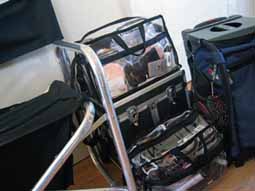
FIGURE 12-3: A TREATMENT BAG AND FILM DAYCHECKER BAG AND CHAIR
NOTE: most artists have a makeup kit or case, a makeup bag with additional supplies (including a treatment bag), a set bag or case, and a set chair. The average pieces are three. Some artists are great packers and have it down to two!
Gretchen’s Treatment Products for the Treatment Bag
• Kiehl’s Ultra Facial Moisturizer for all skin types
• Kiehl’s Sodium PCA Oil-Free Moisturizer (for those who do not want any oil added to the surface of their skin)
• Kiehl’s Cucumber Herbal Alcohol Free Toner (transfer to a smaller bottle, or use the travel size and refill from the large 16.9-ounce container when needed)
• Kiehl’s Blue Astringent Herbal Lotion (transfer to a smaller bottle, or use the travel size and refill from the large 16.9-ounce container when needed)
• Kiehl’s Close Shavers Shaving Formula #31-0
• Kiehl’s Ultimate Brushless Shaving Cream
• Terax Body Moisturizing Shaving Cream
• Kiehl’s Men’s Alcohol-Free Herbal Toner
• Clinique Skin Supplies for Men, M Shave Aloe Gel
• Remington Face Shaver Pre Shave Poudre
• Kiehl’s Washable Cleansing Milk for Dry, or Normal to Dry, or Sensitive skin types
• L’annine Hand and Body Crème
• Kiehl’s Lip Balm #1 with Sunscreen
• Fresh Soy Face Cleanser Makeup Remover
• Lancôme Bi-Facial Double Action Eye Makeup Remover
• Evian Eau Minerale Naturelle Spray
• DHC Coenzyme Q10 Water Mist
• Travel-size container of witch hazel
• Sephora Makeup Brush Cleansing Wipes
• DHC Makeup Off Sheets
• Wet Ones Moisture Wipes Travel Pack
• Murad Day Reform Treatment (works well to apply on the skin before airbrushing)
• Sunscreen SPF 45 or higher
• Rubbing alcohol in a small bottle
• Natura Bisse Sponges
• Small, clean towels
• Eye Tees Precision Makeup Applicators
• Small scissors for cutting cuticles
• Larger scissors for all-around use
• Diamancel Nail File
• Disposable shavers
• No shred cotton pads
• Sugar-free gum or mints in a variety of flavors and brands
• Norelco trimmer
• Tissues
Set Bag
The contents of a set bag or case is an individual’s preference. You can be on-set for long lengths of time, and might not be able to get back to base camp if you have forgotten an item. Also, it depends on if you are watching large background scenes or one or two individuals. Try to keep your set bag lightweight and portable for easy maneuverability while on-set. If you are shooting outdoors, be sure to check the weather conditions. You might need to use a case that is waterproof or covered if rain is expected. A hard, portable gym locker bag works well because it is compact and has a long strap for shoulder use, as well as handles for carrying. It is also waterproof, so it works well outdoors in rustic conditions that may include rain, snow, or high temperatures. Indoors or on smaller shoots, use a clear, larger set bag with long straps, and that rests close to the body.
With a clear bag, the contents are readily visible, which makes it easy to find a specific product. (You’d be surprised at how hard it can be finding items when you need them fast!)
Along with the products mentioned below, a small, clear cosmetic bag containing the products you will need to use on the actor for touch-ups on-set is useful. Large freezer bags would also work. If you have several actors to watch, use individual bags marked with each actor’s name so there is no sharing products between the actors. Most of all, this will keep brushes and powder puffs separate.
PRO TIP
Makeup Artist Jenny King Turko suggests covering up your powder puff with a Kleenex tissue. After touch-ups, toss the tissue away and put a new one around the powder puff. This way, you can touch up large crowds without contaminating other people.
I usually load up three or four puffs ready to go. Bottom line is whatever works for you on deciding what products you like to use.
Gretchen’s Set Bag: Contents for Film Set Day Checker
(See Fig. 12-03 for Picture of Film Day Checker Bag)
• Kleenex tissues
• Peter Thomas Roth Clinical Skin Care Max Anti Shine Mattifying Gel
• Sponges
• Powder puffs
• Wet Ones Travel Pack
• DHC Body Cleansing Cloths
• Evian Eau Mineral Spray
• Pointy Q-tips
• 1 package of disposable mascara wands
• Remington Face Saver Pre Shave
• 1 small bottle of glycerin
• 1 small pair of scissors
• Band-Aids
• Small eye pencil sharpener
• Tweezers, Laura Mercier by Tweezerman
• 1 eyedropper
• 3 Cutex Nail Polish Remover Pads
• Refresh disposable eyedrops
• Visine
• Gum and mints of choice (regular and sugar-free)
• Small Jao Antibacterial Hand Refresher
• Small Bliss Body Butter
• Small Lise Water Solution Double Instant Eye Makeup Remover
• Kiehl’s Lip Balm SPF 15
• Small Kiehl’s Intensive Treatment Moisturizer
• Carmex
• Small Kiel’s Creamy Eye Treatment
• Andrea Eyelash Adhesive
• 2 containers of individual eyelashes in dark brown and black
• 2 eye shadow palettes with the following colors (black, dark brown, light brown, off-white, rust, gray blue, taupe); eye shadow palettes by Make Up For Ever and Viseart
• Yves Saint Laurent Touche Esclat Radiant Touch
• Lancôme Dual Finish Powder Makeup
• Natural Rice Oil Absorbing Rice Paper Tissues with Rice Powder and Bobbi Brown Blotting Papers
• No color powder pressed compact
• Peter Thomas Roth Anti-Shine
• SmashBox Compact Anti-Shine
• 1 red eye pencil
• 1 black eye pencil
• 1 menthol vapor for the eyes
• 1 color each of Tween Time colors for hair
• Small squeeze bottle of Ken Diaz KD151 Flowing Blood Syrup, Drying Blood in Dark and Light
• Skin Illustrator Flesh Tone Palette
• Skin Illustrator FX Palette
• Reel Color Palette Cover-Up/Effects Kit
• Braun electric shaver
The last five items of the above list I store in my set chair (if not needed) and then they are readily available on set.
PRO TIP
Working in HD, I rarely use powder. If you need to use powder switch between several products like anti-shine, blotting papers, and no color pressed powder, to avoid too much build up.
Gretchen’s Makeup Bag for Film Day Checker
The makeup you bring as a Day Checker on a film set can be contained in a bag or case of some sort. If you are directed to bring makeup for a certain character or time period, you should adjust the contents of your makeup bag to fit the need. If the job is going to entail helping out the department head most of the time, and is not so much about applying a lot of makeup, you won’t need to bring a bulky case. A clear bag with a large strap and handle that can accommodate only what is necessary should work. What you do and how you transport your makeup becomes a personal challenge. Changing out your makeup to fit the job at hand happens no matter how well you think you’re organized. Having at home a few different makeup bags or cases already set up and ready to go helps cut down the “What to bring?” question.
(See Fig. 12-03 for Picture of Film Day Checker Bag)
• Air Craft Airbrush Makeup in all colors
• Shiseido Stick Foundations
• RCMA K/MB Palette by Vincent Kehoe
• Sehora makeup brush cleaning wipes
• Visiora MV in all colors
• DermaColor Camouflage System
• Mellow Yellow by Ben Nye
• A few setup towels
• 1 metal palette to blend makeup
• 1 book of artist paper to blend makeup
• 1 palette knife
• RCMA No Color Powder
• Laura Mercier Secret Brightening Powder
• Laucôme Dual Finish Powder Makeup
• Iman Pressed Powders
• Guerlain Bronzing Powders
• Tarte Stick Color Stains in all colors
• Eye shadow palettes in various colors (I like to have a shadow palette that is compact that I can use on anybody for large crowds. Colors in black, dark brown, taupe, creams, white, blue, violet, green, and gray. Personally, I have every N ARS compact that has come out! My favorite for on-set is Skin Deep.)
• Eye shadow palettes in frosty gold tones
• Eye shadow palettes in frosty silver tones
• Blushers (Blushers should be simple. Light pink, coral, burgundy, red if needed, and a warm neutral color. Again, I can usually find this combination of colors in a palette, therefore I don’t need to bring a lot of loose colors. Make Up For Ever has a good combination of colors you can put together. I have one or two creams that I can use if someone has a dry skin tone.)
• Kiehl’s Lip Balm SPF 15 in hues 30G and 58B
• Kiehl’s Lip Balm SPF 15
• Laura Mercier Brow Powder Duos in all colors
• Bobbi Brown Long Wear Gel Eyeliners in all colors
• Brow pencils in all the brow colors
• Eye pencils in black, dark brown, dark blue, dark green, and white
• Lip Pencils: M·A·C Rosewood, Trish McEvoy Deep Nude, T. LeClerc Tendre, M•A•C Mahogany, Guerlain Rouge #2, By Terry #11, #12, Lancôme Lip Coloring Stick Inspire, Mauvelle, Lancôme LipColor Cherub. Plus a few colors that will work in any situation: pink tones, coral tones, reds, burgundy, and a rust color. Yves Saint Laurent Touche Éclat, all of the colors
• A variety of lip glosses in tubes
• Bobbi Brown eye brightener
• Laura Mercier Secret Brightener
• Laura Mercier Eye Basics Liner
• Lancôme Definicils Waterproof Mascara
• Lancôme Definicils High Definition Mascara
• Trish McEvoy High Volume Mascara
• Brush roll with a variety of brushes
• W.M Creations, Inc. Stacolor palette (full palette)
• Hand held fan (for those hot days or sets)
Set Chair
There is not always a reason you have to use the set chair, but it is good to have if you are sitting long lengths of time. In film, it is important because of the amount of time you do spend shooting. Everyone has their favorites. Every day, new bags and chairs surface that we all like to check out. I still like my larger chair that has a pocket below that I can stock up with extra items. You will find yourself storing those extra pieces of clothing for different weather conditions. The chair is compact and easy to move in a hurry. Feel out your department heads and observe what they are doing. In some cases, the Production or Makeup team does not believe in sitting down on the job. Although this is rare, don’t assume that everyone brings their chairs to the set.
COMMERCIAL VERSES FILM
Makeup kits for the commercial world are similar to film. There are a few differences between the two. For one thing, you probably will need to bring a hair kit as well as the makeup kit. In many cases one person does makeup and hair for a commercial. Do not do hair if you are not qualified or comfortable with it. If you are working on a non-union shoot, you most definitely will be doing both. On a union shoot with a budget for two or more artists, they will hire a Makeup Artist and a Hairstylist. The union requires that all hairstylists are licensed in cosmetology and keep their license current.
Just as with film shoots, someone should be contacting you with your call times the day before you are to work. Call sheets are usually faxed or emailed. Follow the directions and get to work on time!
When you reach Crew parking, you’ll be escorted by a van to the Makeup setups. In commercials, RVs are usually used instead of Makeup star trailers. There can be several locations in one day, so traveling is easier for Production in RVs. Plus, the number of actors you’ll be working on at one time can be smaller. Of course, this isn’t always the case.
Once you have set up, an AD should start bringing in your actors. Once done, you’re off to set! On commercials, clients who are representing the company that is being filmed are on-set. Clients are there to make sure the company is getting what they need out of the shoot. Be professional at all times. You never know who is listening or who it is that you might be talking to.
At the end of the shooting day, make sure you’ve filled out your time card. Turn in your time card to Production. Be sure to stay for the actors to help remove any makeup if needed. If there is room, I like to have hot towels available.
Now you can find your way back to Crew parking. Drive carefully and slowly going back home. You’ve worked long hours.
TIME CARDS AND KIT FEES: INSTRUCTIONS
Get your start paper documentation in order to bring with you. On union shoots, you will need a copy of your makeup kit rental inventory, which includes a total value and product list, an invoice for your makeup kit rental fee (or Box Rental), and a copy of your IDs. Whatever you do, don’t forget to bring these in. Everyone is so busy; for Production to hear your reasons for forgetting is beside the point. They need the information to process your start papers so you can get paid. Try to make life easier for everyone. I usually have several copies ready to go ahead of time. Fill out the correct information for that job. I put the papers in my makeup kit so not to forget. The Makeup Department should have your start paperwork on the first day to fill out and turn in. The combination of the papers you brought in and the start papers you’ll fill out are turned in together. If the Makeup Department does not have start papers for you, find the Production trailer and get the papers yourself. Again, it looks good for you to know where to go and what to fill out correctly. If you have any questions about your rate or pay, if no one has told you, or if they don’t know, ask your local union. If the Makeup Department is from a different Local they might not know your rate. Rate of pay fluctuates with regions and union locals. If you think about it, not knowing what your salary will be isn’t very professional.
A Kit Fee is also called a Box Rental and is based on a daily fee paid to you to cover the cost of working out of you kit. It covers your makeup brushes and makeup products—your kit. Almost always, expendables are provided by the makeup department (in film), but always pack plenty of supplies in case they are not there when you start work. Always be ready to work!
Expendables are tissue, cotton balls, sponges, puffs, alcohol, brush cleaner, Q-tips, etc. In commercials you provide everything. If something is needed for the commercial that you have to purchase, you can turn in the receipt for reimbursement. Kit Fees are negotiated for each job; most artists have a standard fee they charge along with their rate. In day checking on a film, the Kit Fee is set by production and the makeup budget; it is not negotiable with day checking.
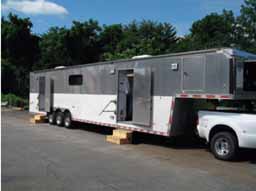
FIGURE 12-4: AN EAST COAST MAKEUP TRAILER—OUTSIDE
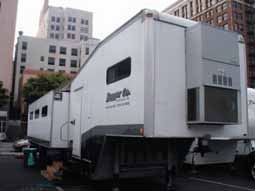
FIGURE 12-5: AN EAST COAST MAKEUP TRAILER—INSIDE
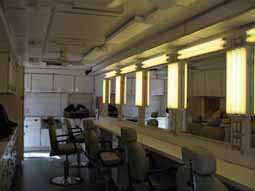
FIGURE 12-6: A WEST COAST MAKEUP TRAILER—OUTSIDE
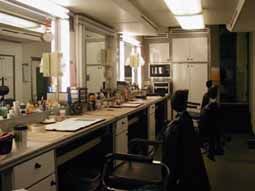
FIGURE 12-7: A WEST COAST MAKEUP TRAILER—INSIDE
PRO TIP
East coast trailers are more stable, and built for cold weather, so they are heavier with less “bounce.” West coast trailers are not built for cold weather so they are lighter and can “bounce” when someone steps in side. “Stepping up” is call out before entering a makeup trailer for this reason. They tend to be wider with more floor space. In Europe, work is done out of customized buses. European buses and trucks are narrower to accommodate the environment: narrow streets and tight parking.
When arriving on-set for the first time, if you do not know where to report, check in with the department head so they know you are here. Knock softly and peek in. There isn’t really any need to go into the trailer unless invited. Remember, the Makeup team could have already been working for hours before you got there. Keep your energy calm and soothing. Makeup trailers bounce, so watch how much you need to go in and out. Do not slam a door. Lift the handle gently to open and close. If invited in, keep most of your things outside the trailer until you get an idea of where you will set up and what you’ll need. I usually leave my set chair outside. If you have already been told where to report, do not go to the Makeup trailer. You do not need to check in with the department head. They have assigned a member of the makeup department to “run” the additional hires or day checkers, and this is the person you will be checking in with.
This way it is great to get notes or directions on where you are supposed to report and what makeup you will be doing that day. Many times you will be asked to go and set up, and the Key Makeup Artist will find you to explain what they want. This could also be the Third or Fourth Makeup Artist. Whoever is in charge of supervising the additional makeup artists and the look of the background artists will be the one to go to with questions.
A typical makeup department has:
1) Makeup Department Head (Chief Makeup Artist in Europe) in charge of designing and running the department
2) Assistant Makeup Department Head
3) Key Makeup Artist
4) Makeup Artist
5) Additional Makeup Artists.
There can also be a Makeup Designer. If there is a Makeup Designer, the department head will work with them in running the department and implementing their designs.
CROWD SCENES
Background refers to background artists (actors) or extras working in a scene.
You will hear many terms for background: BG, extra’s, background players, background artists, and background actors. There can be from 1 to 500 or more background in any given scene. Imagine a park scene with two principal actors sitting on a bench. Everyone around them has been placed by the ADs, with directions from the ADs for their actions and motivations. These background actors have already gone through the Costume, Hair, and Makeup Departments before being brought to set.
Instructions you will hear are:
Working With Background: That means you are hired to do makeup for the actors in the background.
Report to Background Holding or Extras Holding: Where to show up for work, or where to go. Usually a large room or tent away from set, designated for the background.
Check the Background: You are being asked to look at the background that the AD has assembled for you, and to decide who needs makeup and who is ready to go to set. The department head will decide who has this responsibility.
Working in background, you will often work on many actors in one day. The department head will give you directions on what he or she wants as far as the look for the actors. Descriptions of special background can be found on the front of the call sheet. In some cases, the Supervising Makeup Artist will give you a list of the different looks for the background that day. Swiftness is important when working in large crowd situations. Having an idea of what makeup colors and products work or do not work speeds up the process. Always follow specific directions from the department head or Supervising Makeup Artist.
On set note: never touch up a principle actor on set unless you have been asked to cover that person! You do not know the actor’s continuity, so never assume that they need to be powdered or touched up. You are there to take care of the background artists that are around them. So know who the actors are and who you are responsible for, and don’t try to impress your department head by being an over achiever and powdering everyone in sight. If you are unsure, ask!
There are certain makeup looks that are used regularly in film and television. A few of those would be police officers, homeless people, drug addicts, pedestrians, diners in a restaurant, waitresses, bartenders, news reporters, news anchors, and children. The other common makeup situations are for period makeup.
WORKING OUT OF YOUR KIT
You will need a variety of products and palettes in your makeup kit so that you can create any of these looks. “Working out of your kit” is a term used by makeup artists to tell you that you will be creating looks with what is in your kit, and not specially purchased products that are given to you by the Makeup Department. You rely on Industry Standards that are in your kit. As we’ve mentioned before, the palettes from Skin illustrator, stacolors, and Reel Creations are Industry Standards that encourage mixing to create a more realistic makeup that is long lasting and abrasion resistant. They are essential in working out of your kit, and for those unplanned makeup situations where you have to work quickly, on set. There will also be many times that instructions are given to you in “makeup slang” for products. Example: you are asked to “use MV005” or “use Visiora005,” or just “use 005.” These three terms are referring to the same one product, that if you do not know what it is, you will not know that you are being asked to apply foundation using this specific color (Industry Standard). Makeup and film slang abbreviate just about everything, including products, and sometimes instructions. It is confusing at first, but you will get the hang of it Remember, if you don’t know, ask!
Having trouble remembering what colors to use or which looks to do for a certain period makeup? Tape a color chart and notes on each period inside your makeup kit for a quick reference guide.
Remember color mixing from Chapter 3?
Red: You can mix yellow and magenta to get red.
Blue: Mix magenta and cyan.
Green: Mix cyan and yellow.
Purple: Mix violet and magenta.
Black, White, and Gray: Mix white into black until you get the desired shade.
Knowing combinations gives you so many choices to work with!
Now separate the three background actor looks of homeless (Figure 12.8), drug addict (Figure 12.9), and illness (Figure 12.10) to see their differences.
Homeless
• Red or sun-damaged skin with various sizes and colors of sun spots.
• Skin tone has rough, leatherlike surface due to exposure to the elements.
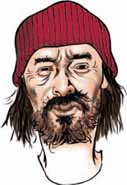
FIGURE 12-8: A HOMELESS PERSON
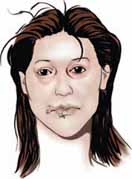
FIGURE 12-9: A DRUG ADDICT
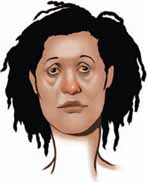
FIGURE 12-10: A PERSON WITH A COLD
• Broken capillaries around the nose and cheeks to reflect substance abuse and weather damage.
• Lesions of various sizes due to illness and injury.
• Ground-in dirt on the body, under fingernails, and even built-up grime from lack of grooming.
• Facial hair would be untrimmed, unshaven, oily, and dirty.
• Darkness, puffiness, and redness under and above the eye.
• Small cuts or scabs on the face, with weathered lips.
• In some situations, the feet must be done as well. The soles of the feet should be blackened with heavy grime, cuts, and bruises.
Drug Addict
• The skin tone tends to be pale and clammy from drug abuse.
• Darkness forms under the eye area from lack of sleep.
• Skin lesions form from drug abuse and illness.
• Track marks on the body from shooting up.
• Bruising on various parts of the body, old and new.
Illness
There are many possibilities for illness: cold, flu, high fever, and disease. You will be directed as to what the illness is, and what the desired effect should be, from the department head or Supervising Makeup Artist. For this example, your instructions are for a cold/flu.
Cold/Flu: Red tones around the nose with dry, flaky skin. Eyes can appear red and droopy, even watery. Paler skin tone that could be clammy. A dryness to the mouth.
Would you apply foundation or do any corrective makeup on these characters? No. The worse they look, the better, in all three scenarios; and you do not want an even skin tone
Red pencil can be used for rimming the eye area or applying right on the lower lash line for irritated eyes. Several shades of red makeup colors are used for broken capillaries, red noses, and lesions. Have on hand different colors of brown or colors to mix browns for dirt and grime. One black is used to deepen or darken an existing color, plus one white to lighten any existing color or to make grays. Yellow is used for nails, skin tones, and festering lesions or old bruises. Care needs to be taken when working around the eyes. Use a cream-based makeup or a freshly sharpened pencil.
Police Officers
One of the first things you’ll do is clean shave all law-enforcement characters. There should be no facial hair, with exceptions given only by your department head. Mustache’s are allowed for most Police Departments. Sometimes sideburns need to be trimmed. The back of the neck needs to clean shaven. The officers should have a clean-cut appearance. On all shoots, be prepared with a good electric razor, shave powder stick, astringent of choice, and a small groomer for eyebrows, ears, and nose.
News Reporter and News Anchors
News anchors and reporters usually have a clean-cut appearance as well. If there is a time period issue, you will be told to address that issue. If it is present time, the anchor look is what to aim toward. Work quickly, and spot cover up only the problem areas. Apply a slightly heavy beauty makeup; to achieve a matte, perfect look. Most of the time, lipstick, blusher, eye shadow, and brows are all you will have to do to achieve a news anchor look. The Hair Department will pull the look together. Reporters and anchor types sometimes are pulled ahead of everyone else to go through the Makeup Department because they are usually featured in the scene.
Period Makeup
Refers to a specific time period for the look or trend of that time. Say you are asked to do a period makeup, taking five minutes for each actress because the actresses are in a large crowd scene. If you could do only three things on the actress, what would you do to execute the makeup properly for the following time periods? And what sets each time period apart from the others? We will give you some very general looks for each decade. You must do your own research for each decade to recognize and know a more detailed history of the trends.
1950s (Figure 12.11): Red lips, pale eye shadows applied to the upper eyelids, nice liquid eyeliner across the upper eyelid next to the lash line, no eyeliner on the lower eye lash line, beautifully shaped and filled in eyebrows. Apply lipstick, eyeliner, and brows. A very clean, sometimes innocent, classic look. Note the shape of the lips.

FIGURE 12-11: A 1950S MAKEUP LOOK

FIGURE 12-12: A 1960S MAKEUP LOOK
1960s (Figure 12.12): Pale fiat or frosty (but never glossy) lipsticks, strong upper and lower eyeliners, contrasting eye shadows on the eyelids. For example: light shadow on the lid; a deep, dark eye shadow in the crease; followed by a light eye shadow applied on the brow bone. The look is about eyes, so note the style in eye shadow, eyeliner, and brows, as well as the lips. Apply lipstick, eyeliners, and eye shadows.

FIGURE 12-13: A 1970S MAKEUP LOOK
1970s (Figure 12.13): Women and men in the early 1970s were riding the wave ushered in by the counterculture from the 1960s. Freedom of expression through fashion and makeup was seeping into mainstream society. Men had cast off the “above-thecollar” hair restrictions of previous decades, and began wearing their hair much longer. In addition, facial hair had become popular, which included long sideburns that often widened as they extended down the face, and full mustaches. Hence, facial hair is a large part of re-creating the ’70s look for men. By the mid 1970s, women kept their hair natural whether long or short. Natural, meaning that it was devoid of hairspray, hairpieces, and setting gels of any kind. Eye shadow was colorful and warm (greens, blues, brown) with or without eyeliner; blush and lips in corals, pinks and frosts. Sun-tanned skin.
Example of a Decade in Makeup: Makeup varies from the early ’70s to the late ’70s, so questions should be addressed to the Makeup Department head on what look they are trying to create. In general blues, greens, and brown colors were worn as eye shadows. Makeup was applied, but not heavy or over-the-top. Dark brown tones or black would be used around the eye area as liner, but much softer than in earlier years. Lipstick colors were found in corals, pinks, oranges, and soft reds. If you had only three things to do to create a ’70s makeup, what would they be?
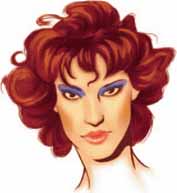
FIGURE 12-14: A 1980S MAKEUP LOOK
1980s (Figure 12.14): In the 1980s, no matter what colors you were using, makeup was applied heavy. Makeup and hair were used as an art form. Depending on who it was that you hung out with, everyone today has a different take on what colors were used in the ’80s. The colors ranged from the punk look (with black liners and dark eye shadows) to the preppy look (girls with rust or fuchsia-colored lipsticks with purple eye shadow). Of course, Madonna always comes to mind when one thinks of an ’80s look. Three things to use for an ’80s makeup: colorful lipstick, full eye shadow, and blusher. Use lipsticks in pinks, purples, fuchsia, rusts, and reds. Apply eye shadows all over the lid and crease, with a dramatic but lighter shade to the brow bone. Complete the look with a dramatic contouring blusher across and just under the cheekbone in a matching color to the lipstick.
PRO TIP
There is a transition for each decade in the looks and trends. It does not happen at the beginning of each decade, but a few years later. So there is an overlap of trends between the beginning of one decade and the end of the previous decade. Livestyle, environment, economics, and character play into it as well. Know the year if possible to achieve the look. If the project is not being year specific but wants a general feel of a period, choose to go for the obvious trends associated with the decade. Research, research, research! Know the trends by heart, it puts you at a great advantage.
LESSONS FROM THE FIELD EXAMPLE OF A BEAUTY MAKEUP (STORIES) SHOOT IN PARIS
by Daniela Eschbacher
When I started out in the fashion industry, I contacted as many Photographers and Stylists as possible to do “test shooting” first to build up my portfolio and contacts. In the beginning, it’s hard contacting everybody and running after magazines. But all that hard work pays off. After working for magazines and commercials, people will get to know you and pass your name and number along. That’s what happened to me. Still, in a city like Paris, it is hard to break in. In fashion, sending out your newest editorials to Photographers and magazines will keep them updated on your work.
Preparing for the Shoot
For commercial shoots, it’s important to have all the information necessary from the client or Photographer. The client normally knows exactly what they want, and they expect the Makeup Artist to realize it. When I get a call for a commercial shoot, I will ask the theme of the shoot, the makeup look wanted, if it’s an inside or outside shoot, and how many models. For beauty, it is important to ask the Photographer the reference of the model. The Photographer can either send her portfolio to you by email, or you can look on the agency’s website for the model’s portfolio book. Once you have all the information, it is time to start thinking about the makeup, products, and to double-check to make sure you have everything you’ll need for the shoot. A lot of times, the Photographer, or even the client, does not know how to express themselves in the form of makeup and colors, so it’s up to me to find the right look. Working in fashion is different from cinema. It can be spontaneous.
Even if you agree on a certain look before shooting, it might all change on the actual workday. On larger, more-complicated shoots, there are meetings before the job. The Stylist knows the clothes, so he or she gives a direction and theme of the shoot. It can be really helpful to work with an Art Director or Stylist because they see the overall image. Sometimes a simple makeup works much better than one too sophisticated or creative. Meetings are important for meeting the team—it makes the whole process interesting, fun, and human to take the time to sit down and discuss the project. Of course, for commercial jobs, meetings do not always happen.
Designing the Makeup
Designing the makeup—especially if I’m working on personal shoots or beauty stories where everybody counts on the creativity of the Makeup Artist—can be stressful. Even so, I love the work and preparation behind it. Before you start to design, get as much inspiration as possible. The internet is one, but mostly books and paintings. For myself, I love to work with color, so before I think about my makeup, I think about all the colors that will be used and what atmosphere or feelings those colors will cause to come across.
Once the colors are fixed, I start with effects: shiny or matte, graphic or shady, simple or complicated. Try to prepare as much as possible, but a lot of inspiration is when you first see the model sitting in the makeup chair.
Makeup Kit
Many Makeup Artists have a separate kit for commercials and photography. That includes me. Commercials are not only very tiring, but you work with actors, which is different from working with models. Actors need much more products and attention throughout the day. Therefore, I always have a security kit with me that includes eyedrops, different bases, a nail kit, body cream and a first-aid kit, to name just a few items. For photography, the makeup kit has a lot of products to create effects, such as glitter, different textures of glosses, all sorts of eyelashes, powders, stones, jewelry, and stencils. Stencils I make myself if possible; the rest I pick up here and there.
Prepping the Model
For fashion or beauty shoots, start with cleaning the model’s face with a mild liquid cleanser (Crealine), and apply, depending on the skin, an appropriate moisturizer. I’m not a fan of heavy creams or moisturizers. Natural oils and vitamins work well without affecting the foundation afterward. Nuxe Multiusage Dry Oil hydrates very well and won’t make the model sweat. It’s very important to check the hands. Nails have to be in good shape. No old nail polish or dry skin. Apply the hand cream. Lips are very important because most models have dry lips. There can be a disaster once the model is in front of the camera, unless you take the time to prep the lips properly.
Sometimes I do a soft peeling to take off the dead skin, and afterward apply Elizabeth Arden Eight Hour Cream—a must for every Makeup Artist.
Beauty or Stylized Makeup
Natural colors work best in most beauty makeup. From creamy white to chocolate brown. Warm colors also work well: pink, rose, peach, and oranges. In beauty makeup, you want to look for textures that could be interesting. Glosses on the eyes create a very fresh look. On the cheeks, eyelashes, and eyebrows, gloss will attract light. Because I work with an airbrush, Temptu products mixed with an SB solution work well.
There are no limits in beauty and fashion. Here are a few examples of different makeups for editorials or a beauty story.
Location Shoot: a Luxury Hotel in Paris
The photographer used artificial light with an emphasis on strong contrasts. So makeup needs to reflect well in the light.
Glosses, Oils, and Shimmers: After cleaning the model’s face, apply natural oils onto the skin and the rest of the body that will be seen. Your goal is to have smooth, shiny, and elegant skin. Let the oils absorb before applying foundation. Use eye products that are moist and creamy in texture, with soft eye pencils to work your shape for the eyes, blending and adding as you go. Purples and chocolate colors work well for this. To increase the contrasts, use a powder shadow in gray or black in only the areas that are needed.
Mascara and individual false eyelashes applied to the outside corners of the eyes add drama and depth. Foundation is applied next. Follow with loose powder to set. Chanel has a good loose powder. A bronzer was used to sculpt and shape the face. Creating depth and contours is important in a shoot with contrast. The brows were shaped by using three pencils in a mix of brown, black, and gray. Colors you use will depend on your model, but a mix of three colors mimics the different colors of hair found in the brows.
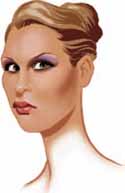
FIGURE 12-15: DANIELE’S LUXURY HOTEL SHOOT
Theme Shoot: Madonna theme
The difficulty was to create color combinations that would express and strengthen the atmosphere and theme of the shoot. I found my inspiration from religious paintings and books. The colors dark red, golden, gray, white, and silver were used. Because wardrobe and hair had such a strong look, I didn’t want to complicate the makeup. When this happens, use a matte, lightly applied foundation, no blush, and no contouring. White eyeliner applied on the inside of the eye will accentuate any color just under the eye. In this case, a red and yellow matte eye shadow from Make Up For Ever was applied on the eyelid and below the lower lashes. No shaping or contouring was used. Shadow was just posed on the lid. When such strong colors are used, a tissue laid under the eye you are working on protects the rest of the face from falling shadow. Loose powder can also be used. Natural lip colors help keep the makeup from being overwhelming. Shape the lips with a nude lip liner. Mix beige, purples, and pink lip glosses to achieve a natural look. Don’t forget to finish off with a strong brow.
Remember, with both makeups, you want to work in layers. Work the shapes and slowly go darker. It’s like working on a painting. To create something luminous and strong, it’s always the combination of colors that accentuate the intensity of another color.
TIPS
To glue anything on the skin or eyes, I use transparent eyelash glue. The only thing you have to be careful of when you glue objects on the skin is to clean around the object afterward. Any sort of glue remaining on the skin tends to shine in photo lighting, and can be obvious in close-ups and beauty stories.
Do not powder the face, especially for close-ups. It’s really difficult for the retoucher afterward to correct it. Powder only certain areas—around the nose, forehead, and chin—at the last minute.
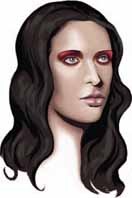
FIGURE 12-16: DANIELE’S MADONNA SHOOT
ON-SET
When working in photography always check your makeup in the light of the studio. The makeup preparation room is always bright, and the light is quite yellow. The studio could be completely opposite. Ask the Photographer to do a test photo to see how the makeup comes across. Most Photographers now work with digital cameras that download right to the computer and show the results straight away. This is very helpful. The Photographer appreciates your taking charge and knowing when it is a good time to redo lips, add some gloss, brush the eyebrows, and powder the skin. It&s so much more interesting to participate in the whole process of making a good photo.
Take Down the Makeup
For makeup removal I normally use Crealine, which is easy to use and good for all skin types. But prepared, de-makeup pads are fast and efficient, too. Some models prefer to take off their own makeup, especially around the eyes and lips. Others have their own products with them, which is understandable because of the amount of makeup they wear for work. Many models prefer not to mix all kinds of skin-care products.
Black-and-White Photograph Tip
In fashion shoots, it is not always said if the job is going to be color or black and white. Sometimes it’s during or after shooting when the Photographer works with Photoshop to see what it could be in black and white. Then the decision is made. If you are told ahead of time, here are some hints to think about. Work much more with the contrasts, and even exaggerate the intensity of colors and shades. There is a lot more “graphism” in black and white than in color photography because we concentrate on the contrasts, shadows, and lighting instead of the color. Graphic lines and structure work very well for the makeup, such as strong eyebrows, eyeliner, nice colored matte lips, nicely posed blushes. Still, it’s important to ask the Photographer exactly how he or she is going to work their light. Maybe the Photographer wants the image to be contrast and sober, or something luminous and mild. Try to avoid too much gloss or shiny skin, except if it’s desired to create a strong and wanted effect. For black-and-white photography, it’s important to have a nice balance between warm and cold tones to make the skin look alive and beautiful.
THINGS TO KNOW
Makeup Brushes
Types of Bristles
Badger: One of the most popular and easiest to find. Badger hair quality depends on an array of factors. The highest quality is the neck hair, which is the softest and most expensive of all badger hair.
Boar: Stronger and thicker than badger hair.
Goat: Strong and soft. It’s used alone or mixed with other hairs in makeup brushes. Goat hair can be found in white, brown, or red.
Pony: Also known as camel hair. This is a term for brushes made from a variety of hair such as squirrel, goat, ox, or pony. Usually brushes made with these bristles are inexpensive and are made in large quantity.
Raccoon: North American animal with a multicolored tail in grays and browns. Raccoon brushes have a really soft texture.
Sable: An animal from Siberia and Japan. Sable is strong, flexible, and takes to products well. Sable can be found in brown, white, or yellow. Kolinsky sable is a mink found in Siberia and China, and is considered the best. Red sable is from the weasel family, and is often used in place of Kolinsky sable.
Squirrel: Hair that is soft and holds water effectively. It works best with liquids.
Synthetic or Taklon: Brushes that are made of nylon or polyester. Synthetic brushes are considered reliable and strong.
Types of Brushes
Angled Brush: These are cut to use at defined angles. Blush brushes, shadow brushes, brow brushes, powder brushes, bronzers, and contour brushes are examples of brushes that can be found cut at an angle. In some cases, the bristles are stiffer.
Blush Brush: Soft, wider, rounded brush used to apply blusher color. Blush brushes are made from a variety of bristles.
Brow Brush: Angled or slant brushes with a stiff bristle for application of brow powders. It’s also possible to find lash combs and brow brushes as duos.
Concealer Brush or Flat Brushes: Concealer brushes are usually flat brushes in a variety of sizes used for cream-based products. These brushes are good for spot touch-ups, heavy coverage with multiple products, under-eye concealer, and blending products. Many flat brushes can be used wet or dry.
Contour Brush: Is used to get under edges and contours of the face to create definition. The bristles are usually cut blunt or at angles.
Crease Brush: Smaller, with a blunter cut in the bristles. Crease brushes are used to apply eye shadows in the crease area and to blend existing work.
Eyelash Combs: Wire or plastic combs that are used to separate the lashes after mascara has been applied.
Eyeliner Brushes: Come in a variety of sizes and bristles. Bristles usually taper to a point, which works well for lining, detail work, powder, liquid, or water-activated makeup such as KRYOLAN or MAC. There are liner brushes that have several different bristles that can be used effectively wet or dry. Also, flat eyeliner brushes can be found.
Eye Shadow or Fluff Brush: There are many different sizes and shapes of a shadow brush. The brushes are used to apply eye shadow colors. The bristles are usually soft, with a rounded shape at the top.
Face or Foundation Brushes: These brushes are usually larger, flatter, with a rounded or oval bristle shape. Bristles can be made in a variety of hair, including synthetic to sable. Foundation brushes can cover wide areas of the face and body, and work well with liquids and creams.
Fan Brush: Shaped like a fan and come in a variety of sizes. Fan brushes disperse powdered makeup and add color with a sheer application. They can be used for applying mascara, as a powder or blush brush, a stipple brush, or as a blending brush.
Kabuki Brushes: Brushes that are often used with mineral-type powder makeup. They come in a variety of sizes and shapes. The most common shape is a fan or dome.
Lash Combs: Lash combs lash are made to separate the lashes after applying mascara.
Lip Brush: There are many choices of lip brushes, from shapes of the bristles to what the bristles are made of. Lip brushes are used to apply lip treatments and lip colors.
Paddle Brushes: These brushes are shaped like a small paddle with a lamb’s wool covering on one side. They are used for blending blush or makeup colors.
Powder Brush: Larger brushes with rounded, softer bristles, often made with goat, sable, or badger hair. They are good for dusting large areas of the face with loose color, or with powder makeup to dust off any excess powder.
Puffs: These are found in so many different brands, shapes, and materials, but all used in basically the same way for makeup and powder application, setting the makeup, and touch-ups on-set.
Pump Brush: Brushes made with the product inside the stem of the handle. When the brush is pumped, the product disperses into the bristles.
Retractable: Brushes that can retract back into the handle of the brush. Some lip brushes and blush brushes are made retractable.
Smudger: Any brush that is used to blend and smudge the makeup.
Sponges: Are used for just about anything you can think of. They come uncut in squares or precut and as a brush form. Good sponges are gentle on the face, do not soak up your liquid or cream makeup, and aid in blending. Different brands of sponges are made from different materials.
Stipple: Several blends of bristles in the brush, plus the shape of the brush works to create textures or as a blender.
Wet and Dry Brush: Brushes that are made with several different kinds of bristles that can be used effectively wet or dry.
INDUSTRY STANDARDS
Antishines
There are many products out there. Antishine creates a matte look to wherever you apply product. We all have our favorite. One that’s been around for a while is Make-up International’s Face to Face Supermatte. It works well for large crowd scenes.
Adhesives
Beta Bond Plus by Premiere Products, Inc.: Acrylic adhesive for prosthetics.
K.D. 151 Ultra Matte Lace Adhesive: Strong adhesive hold for action-packed situations.
KRYOLAN Water Soluble Spirit Gum: Removes with soap and water.
Pros-Aide: Acrylic based, waterproof, strong hold, used mostly for appliances.
Telesis 5 Adhesive by Premiere Products, Inc.: Silicone-based adhesive.
Very Flat matt Matt Gum by Naimies: Used in the industry for lace fronts, facial hair, or wherever you don’t want to have shine.
Xtra Hold Spirit Gum and Extra Hold Plastic Spirit Gum by W.M. Creations, Inc.: Two of the most popular spirit gums in the industry. Used for fine lace fronts, foam, gelatin, and silicone appliances.
Brush Cleaners
Cinema Secrets: Fast drying.
Naimies: Fast drying.
Effects Products
AM.E.K. Liquid Plastic by W.M. Creations, Inc.: Use in stone or silicone molds for wounds.
Gelatin in Bulk: Burman Industries carries gelatin products.
Latex Products in Bulk: Burman Industries carries a wide range of latex products.
Old-Age Stipple
Old Age Stipple Crusty by W.M. Creations, Inc.
Green Marble SeLr by Premiere Products, Inc.: Developed by RSD Inc. and CMI. Seals makeup, very durable, safe for sensitive skins, and also works as an aging product.
RCMA Old Age Stipple
Pax Paint
Tom Surprenant Pax Paints
Pax Paint by GM Foam: Premixed Pax Paint colors that match up to RCMA.
Foundation Colors
Plastic Sealers A, B, Soft, Extra Soft, Shiny by W.M. Creations, Inc.
Scab Materials Light, Medium, Dark, and Brown by W.M. Creations, Inc.: Pigmented, silicone-based liquid that is used for building up three-dimensional scabs.
Scar Material by W.M. Creations, Inc.: Acetone-based plastic material used to build things such as keloid scars and blisters.
Silicon Product in Bulk
Smooth-On Inc.: Easton, Pennsylvania-based manufacturer of Silicon Products. Their website sells direct.
Burman Industries: Carries a good inventory of silicone-related products. Based in Van Nuys, California.
Tattoo Ink Type Products: All of the products mentioned are Industry Standards. It’s hard to remember what it was like before these products existed.
Reel Creations Palettes by Reel Creations.
Reel Creations Liquids by Reel Creations.
Skin Illustrator Palettes by Premiere Products, Inc.: Created by Kenny Myers/CMI.
Skin Illustrator Liquids by Premiere Products, Inc.: Created by Kenny Myers/CMI.
Stacolor Palettes by W.M. Creations, Inc.
Stacolor Liquids by W.M. Creations, Inc.
Tear Products
Burman Industries Menthol Blower and Crystals: A must for any makeup kit.
KRYOLAN Tear Stick
Makeup Products
Foundation or Correction Makeup
Ben Nye Mellow Orange: Neutralizes blue and green.
Ben Nye Mellow Yellow: Red neutralizer.
KRYOLAN Dermacolor Mini Palette: This makeup covers well, has a large selection of colors, and is easy for doing quick makeup or touch-ups on-set.
IMAN: Excellent makeup line for a range of skin tones from light to dark, including yellow. Great pigment in their shadows, blushers and lipsticks.
RCMA: Without question, a makeup line we could not do without. Foundation colors come in every possible range for any beauty or character makeup. One of the few makeup lines that understands skin tones.
Visiora: A sheer makeup that has a good coverage. Colors have been formulated to match our industry lights and different media. Visiora is also a wonderful makeup to use on men.
Water-Activated Makeup
Ben Nye: Good for theatrical use.
Mehron: Good for theatrical use.
Studio Fix by MAC: Good for flesh tones, editorials, and stylized beauty makeup.
Makeup Palettes
Viseart Palette of Neutrals: A simple palette of neutral colors. This palette is perfect for your set bag.
Powders
Kett No Color: Pressed powder
No Color Powder by RCMA.
Removers
It’s always a safe bet to buy the same remover and adhesive that belong together.
Adklen Cleanser by RCMA: No travel-safety issues.
Beta Solv Remover: Works to remove Pax Beta Bond by Tom Surprenant.
Ben Nye Bond Off: Removes spirit gum, medical adhesive, and Pros-Aide.
Delasco Detachol: Removes Pros-Aide. Is mild and hypoallergenic.
Pax Remover by GM Foam: Removes Pax Paint.
RJS Adhesive Remover: No travel-safety issues.
Super Solv by Premiere Products, Inc.: Non-oily. Extra strength but safe for sensitive skin. Gentle enough for lace fronts.
Sealers, Primers, and Fixers
Sealers protect your work, act as a stronger bond for adhesives, and act like a shield between the skin and a product.
Green Marble SeLr Spray: Also can be used as an aging product.
RCMA Matte Plastic Sealer
Soft Sealer by W.M. Creations, Inc.: Also can be used as an aging product. Can be sprayed or stippled over makeup.
Top Guard by Premiere Products, Inc.
